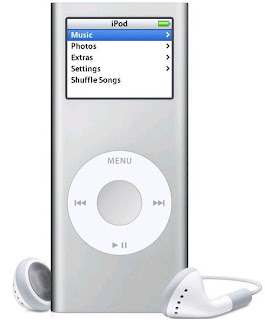Create Your Own Podcast in 7 Easy Steps
Wednesday, March 28, 2007
 For those of you who have been wondering what all the podcast frenzy is about can easily get on board. This post with help you get started. Podcast expert Donna Gunter explains which resources will help you get there.
For those of you who have been wondering what all the podcast frenzy is about can easily get on board. This post with help you get started. Podcast expert Donna Gunter explains which resources will help you get there.Listening to podcasts isn't something I enjoy or take time for, quite frankly. I'm a visual learner and prefer to read something rather than listen to it, as I find reading a much quicker way to gather the info that I need. However, with the proliferation of audio listening devices, like the whole iPod family and other mp3 players, I have to acknowledge that I'm in the minority, I believe. The world is listening to a wide variety of audio files, much more so than ever before in history, and I need to get on the bandwagon or be lost in the dust.
What is a podcast, anyway? A podcast is an audio file that you create in .mp3 format that is uploaded with an RSS (Really Simple Syndication) file to your server for your target market to download on any number of programs created to receive or subscribe to your audio file so that they can listen to it at their leisure on their computer or a personal mp3 device.
Why should you create a podcast? I think it serves as a marketing tool for the solo service professional, who might want to do one of the following:
- create an Internet radio show or talk show in which you create content-rich broadcasts for your target market
- conduct a teleclass series in which you interview experts who have solutions to problems faced by your target market
- promote a printed book, ebook, or CD/DVD series by releasing promotional snippets to a wider audience
- provide short and valuable expert tips to your target market (my Get More Clients Online podcast consists of the weekly article I write for my newsletter)
Many podcasts are about an hour in length, especially when they consist of recordings of radio shows or teleclasses. However, I think that the listening threshold for most people is about 10 minutes. So, that means that your podcast needs to be 10 minutes or less in length. If it's longer, you really have to grab their attention in the first 10 minutes to keep them listening for the full amount of time.
Good content and a good speaking voice are key to maintaining interest. Don't make your podcast one long advertisement for your services or products -- share some useful information with your target market to help them solve their problems. And, you need to have a good speaking voice. Nothing is worse than listening to someone read a speech with a monotone delivery.
So, for maximum impact when you record your podcast (especially if you're just recording yourself), get up and walk around, smile, gesture, or do whatever you normally do when you deliver a speech. Modulate your voice, in much the same way that you would when you have a 1:1 conversation with someone -- put feeling and emotion into your words. I pretend like I'm talking to my best friend, and that helps me with a lively delivery.
What are the Steps to Creating a Podcast?
1. Listen to a few podcasts to get a feel for what others are doing. To listen, you'll need a podcatcher (podcast reader), which permits you to subscribe to podcasts in the same way you subscribe to blogs. I favor iTunes as my podcatcher of choice, which is a free online download. You'll also need to find podcasts, and the quickest way to do that is via podcast directories, which include the iTunes store.
2. Plan your podcast. Who is your target market? What do they want to listen to? How will your podcast be unique from others in your industry? What's your format (interview others, host a teleclass, or record yourself)? How long will your podcast be? How frequently will you deliver your podcasts?
3. Record your podcast. Many people choose to record their podcast with a frëe piece of software called Audacity. It has an easy learning curve and advanced features for more experienced podcasters. Mac users might want to look at Garage Band. For best recording sound, don't use the microphone that came with your computer or that is built into your laptop. You'll want to get a more professional one, such as the ones offered at Plantronics or Radio Shack.
4. Save and upload your podcast to your server. Once you've created your podcast in an mp3 file, you have to save it and upload it to a server via an FTP program (like CuteFTP) so that it's readily available. You can upload it to your website, or use one of the many podcasting hostíng services available. The problem with uploading it to your website is that audio files are space hogs, and you can quickly exhaust all the storage capacity of your hostíng account, not to mention your monthly bandwidth capacity if your podcast is popular and is downloaded frequently. That's why I use a fee-based audio service hostíng company, Audio Acrobat, which offers me generous storage and bandwidth capacity for a semi-annual fee. Another popular podcast hostíng company is Hipcast.com.
5. Create your podcast feed. You can create your podcast feed from scratch, but I recommend you use a feed service to do so. If you use a podcasting hostíng service, this feature is included in your service package. For everyone else, the quickest way to create your podcast feed is through Feedburner.com. This is the same service that creates RSS feeds for blogs. The advantage of creating your podcast feed from this site is that you can create a browser-friendly feed, track your circulation, and enhance your feed with its SmartCast technology.
6. Publish and promote your podcast. If you use a podcasting hostíng service, the service will publish your podcast and notify various podcast directories about the availability of your new podcast. Or, you can enter the info directly into the major podcast directories.
You'll also want to promote the podcast on your website, blog, and in your email newsletter. One of the easiest ways to do this is to add feed subscription buttons (called chiclets) to your sites. You'll have to cut and paste the HTML code into your templates to create the chiclets. You can get directions on how to publish subscription buttons from the various podcasters you want to feature. Lastly, you'll want to create "album art" for your podcast, or a graphic representation that many podcatchers upload with the mp3 file. Album art may be from 170x170 to 300x300 pixels square at 72 dpi. Any graphic designer can help you create this graphics file.
7. Make money from your podcast. Advertising on podcasts is still fairly new, but some companies like Fruitcast.com or PodcasterAds.com are places to start. Another option is to place Google Adsense listings on all of your sites listing your podcast, or seek sponsors for your podcasts, just like you would for a radio show.
Don't let the audio world pass you by! Podcasting is a very inexpensive way of helping you get the word out about what you do and what you offer to the world.
About The Author
Online Business Resource Queen (TM) and Online Business Coach Donna Gunter helps self-employed service professionals learn how to automate their businesses, leverage their expertise on the Internet, and get more clients online. To sign up for more Free tips like these and claim your Free gift, TurboCharge Your Online Marketing Toolkit, visit her site at http://www.GetMoreClientsOnline.com. Read about running an online biz at her blog, http://www.getmoreclientsonlineblog.com or subscribe to her Get More Clients Online Podcast.

 Marketing Blog founder and top-selling author Michael Fleischner has been featured on The TODAY Show, ABC World News, and Bloomerg Radio.
Marketing Blog founder and top-selling author Michael Fleischner has been featured on The TODAY Show, ABC World News, and Bloomerg Radio. 
0 comments :
Post a Comment
Please note that we reject all posts that clearly are leaving a comment simply to acquire a back link. Only comment if you have something of value to share with other readers.
Thanks!